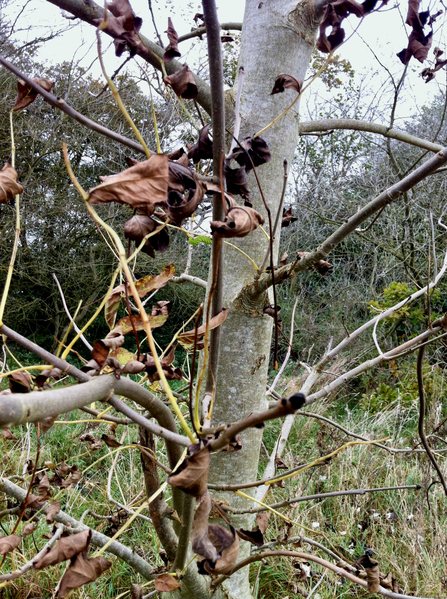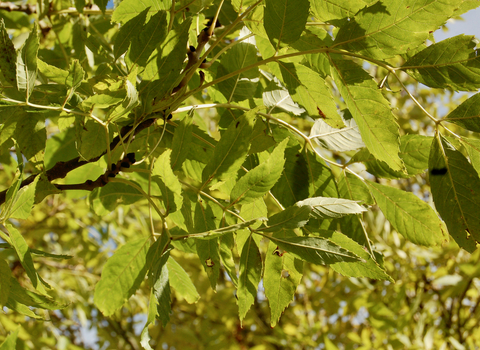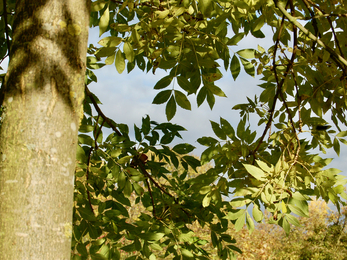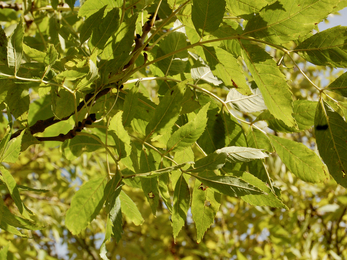Ash Dieback disease (Hymenoscyphus fraxineus) affects our native ash tree (Fraxinus excelsior), initially causing trees to lose vigour through leaves withering and dying, progressing to death of twigs, branches and trunk. In most instances, eventually the whole tree will die.
As this disease spreads through our three counties it has the potential to profoundly change our familiar rural and urban landscapes and particularly our boulder clay woodlands with the loss of mature stately grey skinned ash trees.
About ash dieback
Visible impact
Ash dieback is a disease which affects ash trees, caused by a fungus called Hymenoscyphus fraxineus. The effects of the disease have become more evident to staff, volunteers and visitors as it has quickly spread through our nature reserves in Cambridgeshire over recent years, and is now evident everywhere there are ash trees. Ash trees become gappy, with loss of leaves and whole branches often with some denser new growth patches further down.
The disease causes the trees to become unsafe and they generally die within a short space of time. Across our nature reserves this disease affects seedlings, saplings young and old trees. The most pressing issue for us is the loss of the mature trees, both as a loss of habitat for other species and changes to habitat structure and its general character.
Secondary infections
Other fungi take advantage of their weakened state and cause secondary infections. High on trunks, the orange and brown brackets of Shaggy polypore fungus (Inonotus hispidus) - a heart rot fungus - weakens the stems of ash trees. making them weak and more likely to fail unexpectedly, although also easier for woodpeckers to excavate nests sites and bats to use larger decay holes. Honey Fungus (Armillaria species) are more able to attack the tree's roots and trunk bases, destroying its ability to transport water and nutrients from roots to crown and hastening death - and potentially causing them to fall whilst the canopy is still full.
Current management
Assessment
In the short term, we are assessing all our nature reserves with ash trees to ensure that diseased trees do not pose a significant risk to people or property and we are taking action to reduce these risks where identified. With ash being such as common tree this does mean assessing a large number of trees across all our nature reserves covering quite a significant area.
Risk management
Given the risks, including unpredictable branch drop or tree drop due to compromised root systems, to those managing the trees as the disease progresses, we have had to develop new ways of safe working to minimise these risks. These systems and the increase use of machinery is key to keeping those working on dead and dying trees as safe as possible but does lead to increased costs in equipment and machinery.
Tree felling
This work ranges from individual trees that can be dealt with by qualified staff to hiring specialist contractors and machinery to manage mature groups of trees near buildings or highways. The costs vary considerably but on a larger scale in woodland situations there may still be opportunities to be able to generate some income where the less affected trees still have value, if they have not decayed significantly.
Habitat diversification
We are managing our larger woodlands to diversify the habitat structure, which helps to promote an increased regeneration of young ash trees, with the hope that new combinations of genes will confer increased resistance in a new generation. This is achieved through woodland management techniques of opening up areas of woodland and leaving individual ash trees or thinning out dense stands of ash trees and allowing the most vigorous remaining trees more space and the best chance of combating the disease and setting copious seed.

Caroline Fitton
Looking to the future
Uncertain long term impact
On the positive side, for wildlife there is more deadwood, habitat for around a third of the woodland foodweb and more light for other plants, but also this is the loss of ancient coppice stools. These stools have been cut for centuries and their very presence and shape tells the history of generations of woodland use and management. We are having to look at what this will mean for nature reserves in the coming years and decades especially where ash is a common or the most common tree in some of our woodlands.
No easy replacement
Ash casts a light dappled shade and grows quickly into a large tree and has leaves that are quick to decompose into the soil, with the help of worms. Many of the trees that may replace ash have denser shade and slower leaf decomposition that may also mean changes to the woodland ground flora, not least as soils become less fertile and more acidic - for instance if oaks become more common.
Further information
Ash dieback - what's our position?
Ash dieback: our Position Statement - 12th July 2021
Ash dieback, Hymenoscyphus fraxineus (referred to in the media as Chalara fraxinea), is present across the three counties in areas of woodland as well as the wider landscape from hedges to street and garden trees. This includes our important ancient woodland nature reserves.
Ash dieback has had significant impacts in mainland Europe. Danish research suggests that the species probably arose in Asia from the closely related Hymenoscyphus albidus, which is a widespread saprophyte of ash-leaf litter. It entered the UK through imported trees and was first identified in planted woodlands in East Anglia, Kent and Sussex.
Research also suggests that a small percentage of ash trees are able to tolerate the disease to some degree and the hope is that this trait could be inherited.
The disease is now widespread across the UK and there is no likelihood of it being eradicated from the UK. It is therefore important that short to medium term measures are carefully considered and healthier mature Ash trees are retained to act as seed trees with the hope they will be able to pass on tolerance to new generations..
The Trust will follow biosecurity measures to reduce the already-low risk of transmitting the disease by direct transfer of infected organic material to non-infected sites.
Answers to your questions
We have listed answers to some of the questions you may be asking about Ash dieback below, if there is something you need to ask which is not listed please contact us..
1.) Is this disease harmful to me, or to my dog?
No this disease is not harmful to you or to any animals. It is only harmful to ash trees.
2.) What does the disease look like and how does it affect the trees?
There is a pictorial guide to identifying Ash dieback. Disease spores in the air infect ash trees through their leaves. Once infected the fungus causes stem death in branches which results in the crown of the tree dying back. Eventually most trees will die. Young trees will die quickly whereas older trees may take several years to completely succumb.
3.) What do I do if I think I have seen an ash tree with the disease?
If you suspect a case of Ash dieback having checked the pictorial guide,
The disease is now prevalent across our region affecting most Ash trees. Contact the Wildlife Trust if you consider one of our trees affected by disease to be hazardous to property or people.
4.) How did the disease get to the UK?
We don’t know, but the pattern of infection suggest that trees in England have become infected mainly through the import of infected trees from Europe for new woodland plantings. It’s highly likely that our reserves were also infected by spores then getting to the wood on the wind.
5.) Can this disease be cured? If not what will happen to the wood and the trees?
No cure currently exists but research suggests a small percentage of ash trees are able to tolerate the disease with limited impacts to health and growth. It is hoped that this tolerance is inherited by future generations, but as yet there is little evidence for this. It is predicted that in the long term the few trees able to tolerate the disease will be the means of future survival but that Ash will become much less common. Woodlands will be significantly changed in our area as Ash are often the dominant woodland tree. Its characteristics of leafing late in spring, casting a light shade and has quickly decomposing leaves promotes a varied and rich ground flora. Other trees will however gain a competitive advantage and we will see different trees dominating woodlands, perhaps with profound changes to the plants that can grown in their deeper shade.
6.) If I visit the wood will I spread the disease to my garden at home?
Current research suggests that spreading the disease on clothing or footwear is a low risk, but cannot be completely ruled out. The disease is spread via airborne spores but can also be transferred by leaves or twigs.
7.) Can the disease be spread on my clothes and boots etc? How do I stop it?
See above, and we advise that once you have left the wood, clean your clothes and boots of organic material as best you can, though we repeat, spread in this way is very low risk.
8.) I have seen contractors working on the wood, what are they doing? Will they spread the disease?
We regularly use contractors to undertake woodland management. At some reserves contractors are felling trees as part of the conservation management plan; the felling will maintain the reserve’s value for wildlife. We have agreed with the contractor a working method to reduce the risk of transmitting the disease to other sites. Some contractors along with staff have been removing dead and dying Ash trees from high risk locations or where we would like young ash seedlings and saplings more space to grow.
9.) Will this disease kill all the ash trees in the UK?
No, a small percentage should prove tolerant, see question 5.
10.) Is there anything I can do to help?
You can also support your local nature reserve by becoming a member of the Wildlife Trust. Managing Ash dieback is going to make reserve management more costly, but with your support we can continue to ensure nature reserves remain wonderful places for wildlife and people. Our woodland nature reserves contain a high genetic diversity of ash trees and these are the best places to expect tolerant old and young trees to exist and have room to spread.
11.) What is the Wildlife Trust’s position to the new strategy set out by DEFRA on the 6th December 2012?
We support The Wildlife Trusts position on Ash dieback.
You can find a very detailed and comprehensive Q&A on Ash dieback on the Forestry Commission's Research website.
Additional info and links
- Read the UK Wildlife Trusts' pages on ash dieback disease
External links
Here are links to the relevant Forestry Research website pages which provide much useful general information, plus identification guide.



